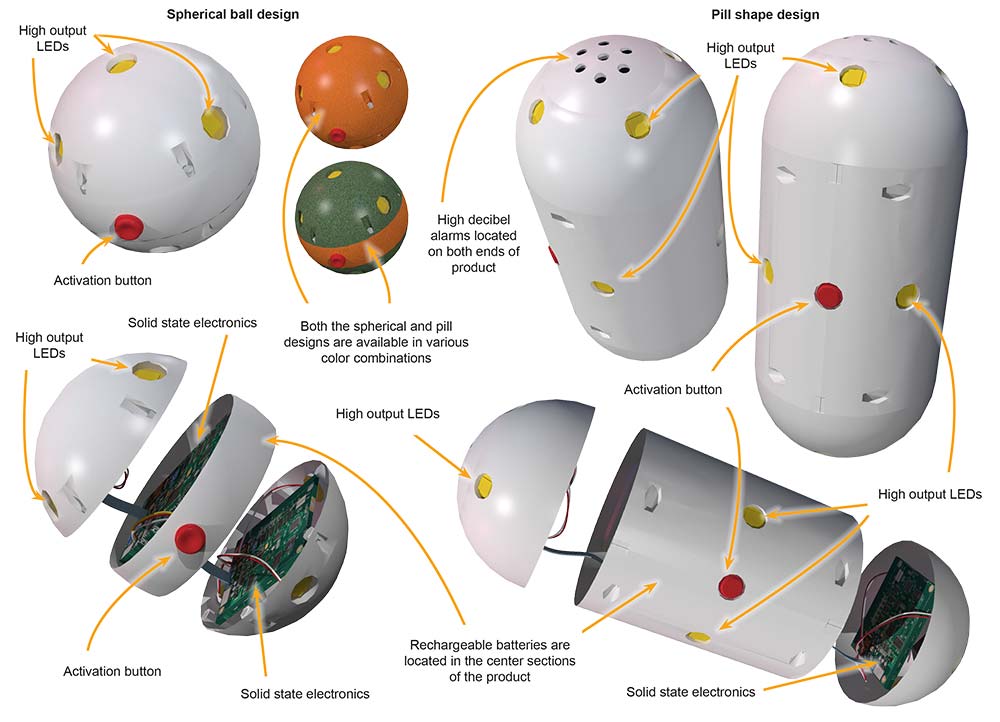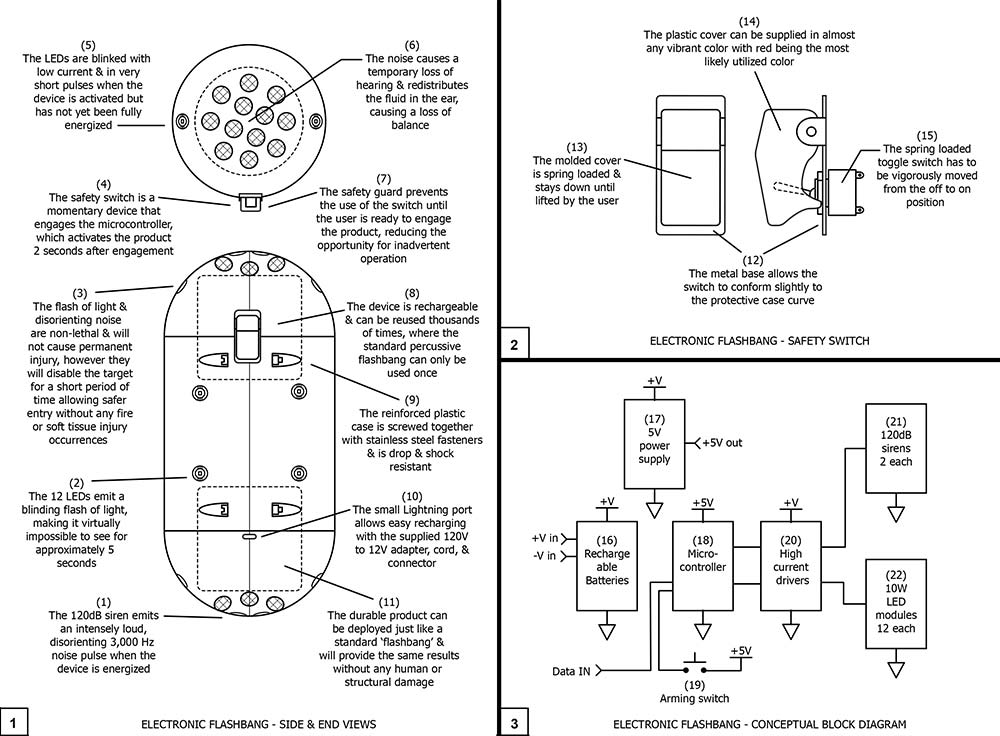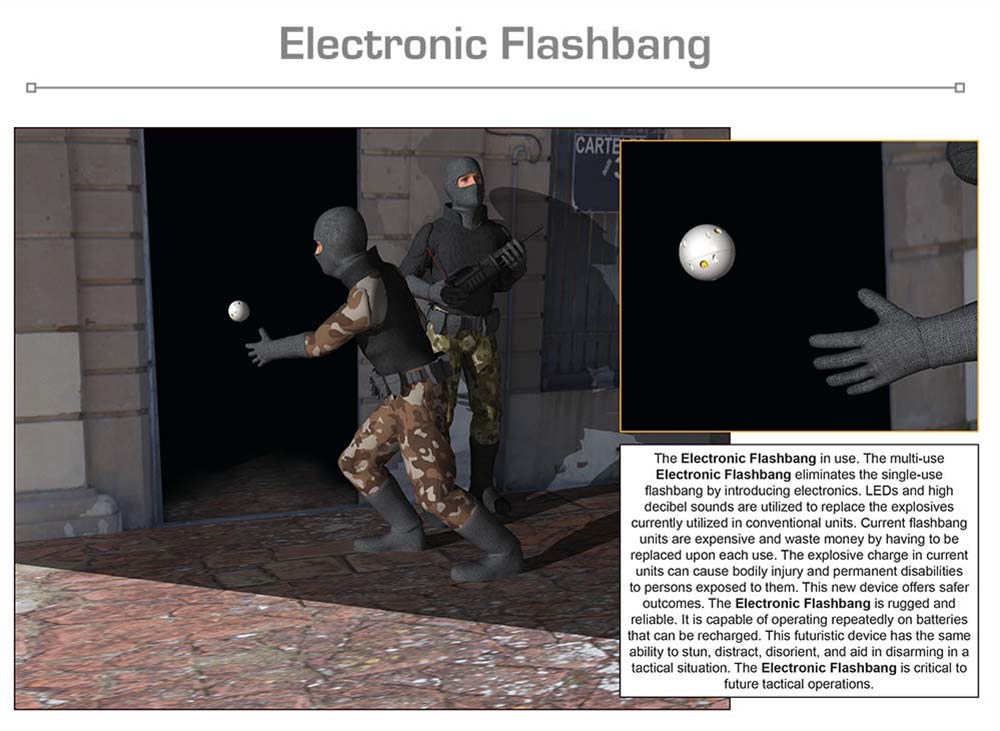
Electronic Flashbang
DESCRIPTION:
The tactical stun grenade or as it is popularly known “flash bang or flashbang” has been a vital device in the inventory of police, SWAT, and military tactical teams worldwide for many years. The flashbang was originally conceived as a non-lethal device designed to produce a blinding flash of light and a high-decibel “bang.” Created in Britain for the Special Air Service’s Counter terrorist wing, the “flashbang” has seen service in most areas of law enforcement and military groups. The flashbang, when activated, momentarily activates the eye’s photoreceptor cells causing temporary blindness. The eye will restore itself to a normal state, but an afterimage will be visible for a longer length of time. The loud blast is meant to cause a temporary loss of hearing and can also disturb the inner ear affecting balance. The hearing will return to normal after a period of time.
The flashbang’s original concept was to be a non-lethal device designed to assist in critical situations where hostages, other innocent persons, or other situations when the desire to use non-lethal force is directed. However, the original flashbang’s use of the pyrotechnic material in its construction created a concussive blast that has proven to cause permanent injuries and even death in some cases. The pyrotechnic material used can cause fires by igniting flammable materials that may be present. Persons in closer proximity to the activation of the flashbang can suffer serious burns, injury, sometimes fatal. The traditional flashbang is an explosive device, and all the danger associated with explosives will be present when it is in use. The flashbang is also a one-time use device and requires replacement each time a unit is deployed in service.
Current technical innovations with sound and lighting devices would infer that the explosive pyrotechnic device should be replaced with a safer and actual non-lethal product that can be reused.
The Electronic Flashbang is an innovative and unique product designed to replace the pyrotechnic version of the flashbang grenade. Built of sturdy impact and fire resistant materials, the Electronic Flashbang presents a stun grenade that consists of solid state electronics that can control sound and light emissions of programmable levels to produce the same or better effects of the current flashbang grenade that is now in use. The Electronic Flashbang comes in two distinct shapes, but could be redesigned in any other desired configuration. The spherical version fits the hand nicely and is easy to throw accurately. An elongated version that is known as the “pill” form is also proven to have the same characteristics as the spherical type. Both versions feature high-intensity LEDs located at strategic points on the product’s exterior. Internal speakers capable of producing high decibel sounds are additionally featured on the Electronic Flashbang. The same disorienting flash and high-decibel sound created by the current flashbang is present with the Electronic Flashbang. The unit design is for use in military, tactical, and police situations with the same effects but without any lethality of the pyrotechnics being present. One of the Electronic Flashbang’s capabilities includes the rechargeable batteries contained within the Electronic Flashbang’s structure. Once deployed the Electronic Flashbang recovery assures that it can be re-charged and brought back into service when needed. Each unit activates with the push of a trigger button programmed for time delay. (A trigger cap or pin, similar to a grenade pin, could be incorporated. A secure feature could be programmed into the device to prevent reuse and cause proactive compromise of the electronic components, if the device is acquired by unauthorized persons) This device offers the same effect as the pyrotechnic flashing grenade but without any of the lethality and waste. The Electronic Flashbang is the future of the stun grenade with military, tactical units, and police forces.
SPECIFIC, UNIQUE FUNCTIONS OF INVENTION:
- No pyrotechnics used
- All solid-state electronics
- High-decibel sounds (Programmable sequencing and intensity)
- High intensity LED flash (Programmable intensity, flash pattern, and other color options)
- Non-lethality is assured
- Replaces current stun grenades
- Reduces waste
- Units are rechargeable and can be reused
- Fireproof and impact resistant cases
- Saves time and expenses
- Simple straight forward use
- Cost effective
PRODUCT COMPONENT CLARIFICATION:
The “Electronic Flashbang” is an innovative tactical disorienting product that has been designed to create a blinding flash and an extremely loud sound to make entry by police, SWAT, and or military tactical teams safer. The electronic product has a very rugged plastic case that contains 2 piezo sirens, one in each end facing outwards, and 12 LED modules positioned uniformly around the case. The battery powered product produces a very loud noise pulse and an exceptionally bright flash that are synchronized together. The light and sound effects are non-lethal and disappear over time. The product performs the same function that a military percussive device does but will not physically harm humans or cause damage to building or interior furnishings, and when recharged, will repeat this function thousands of times.
Currently, the ‘flashbang’ deployed by the authorities is a percussive device that is fabricated using a metal/oxidant mix of chemicals. These are ignited by a fuse and when they explode, produce a large magnitude flash of light and very loud burst of sound. The light overpowers the photoreceptor cells in the eye, making vision impossible for approximately 5 seconds, after which the vision slowly returns. An afterimage will also be visible for minutes, impairing the person’s ability to aim accurately. The explosion also creates a very loud noise, which causes a temporary loss of hearing and disturbs the fluid in the inner ear causing a loss of equilibrium. The problem with this munition is the chemical explosion, which can ignite flammable material where it goes off, can burn humans or pets in the room, maim the user if an error is made in delivery, and can destroy items if the fuse happens to be ejected upon exploding. Another problem is that these grenades are one time use devices and the cost to maintain an arsenal can be excessive.
The “Electronic Flashbang” resolves almost all these problems by providing an electronic analog of the chemical explosion while maintaining the safety of the user, targets and infrastructure. The battery powered product produces a very loud noise pulse and an exceptionally bright flash that are synchronized together, albeit being optimized to embrace the benefits of the generation. The battery powered product employs 2 sirens positioned on the ends of the case and 12 LED modules that are distributed uniformly around the case. The 120 dB noise pulse is generated by solid state sirens, one at each end of the rugged plastic case, whose output is additive, making it even louder. The 10W white LED modules are overdriven for the short pulse of time that light is being generated, making them even brighter. Altogether, the LEDs put out a minimum of 7,800 lumens, which is very bright indeed. The product is prevented from inadvertent operation through the use of the spring loaded safety switch and when activated, pulses the LEDs at low power to encourage the user to drop it into the room. The microprocessor controls the operation of the product, engaging the light and sound at 2 seconds after activation. The device is operated for the specified length of time or until the battery is depleted, whichever comes first. The device is recharged using the 120V to 12V adapter and the Lightning connector.
The plastic case: The case is injection molded in 4 sections using fiberglass reinforced polypropylene plastic. This case clamps onto the end caps and uses stainless steel fasteners to firmly secure the case into one solid device. The device is very rugged and the empty case will survive a drop shock of 25’ without degradation, regardless of orientation. The openings in the case are sized and shaped to protect the internal components during use, yet allow maximum transmission of the sound and light.
- As an option: The pill shaped case can be substituted by any other shape that the manufacturer can create and their marketing believes will sell optimally. This can be a ball, a tri-lobe, or almost any shape.
The internal electronics: Each of these following components is mounted securely in the case so the product can meet a drop shock of a minimum of 10’ allowing survivability over multiple uses without degradation. These electronics are assembled into the case using a mixture of commercially available components and contract assembled sub components. These are, but not limited to, the following.
- The microcontroller: This is a very low power requirement, 8 bit RISC, solitary chip microcontroller operating at 16 MHz. It has onboard chip flash memory, 256 KB flash and 32 KB of RAM, which can be increased through the use of external sources if more memory is required. The product can be updated and programmed through the Lightning connector as well using a laptop computer. An Arduino Micro was used in the prototype.
- 5 volt power supply: This commercially available power supply chip is mounted on the controlling PCB and feeds the microcontroller.
- High current drivers: These drivers take the output signals of the microcontroller and convert it to a high power burst of energy that drives the LEDs and excites the sirens to put out the maximum sound. These can be commercially available driver modules or can be assembled using standard components on the controlling PCB.
- The batteries: These are 9.6V NiMH, 1600mAHr devices. They are of a size to be able to be packaged within the case outlines. These batteries are rechargeable using the 120V to 12V adapter, cable, and connector. The batteries are capable of supplying a minimum of 11,520 mA over the 2 second operation range and have a bit of life left.
- The LEDs: The LEDs are commercially available clear white modules that will put out 10W of light. Each of the 12 modules produces 960 lumens of light with a forward voltage of 10.5V and a forward current of 900mA. The modules can take up to 2,000mA maximum over short periods of time, permitting even more dazzling light to be generated. It is anticipated that the product baseline programming will put out a temporarily blinding pulse of light for around 1 second.
- In operation, the LEDs use a short pulse of voltage at 900mA per module.The wiring must be carefully sized to insure its insulation does not melt and the LED modules must be allowed to cool between uses because they do not have any heat sinks due to packaging constraints.
- The sirens: The commercially available sirens will put out 123 dBa at 10 cm or around 120 dBa at 3’when driven with 9.6VDC at 260mA. The siren drivers will turn the sirens on at the same time as the LEDs are initiated, and then will keep the sirens on for a short period longer than the LEDs are operated. This allows the maximum disorienting impact of sound to go along with the light pulse. It is anticipated that the product baseline programming will put out a temporarily disorienting pulse of sound for around 2 seconds. The sirens are about 2” in diameter and about 2” long so they can fit up in the ends of the case, projecting all of the sound pressure outward through the openings in the case ends.
- The printed circuit board (PCB): The PCB for the device is fabricated to the final assembler’s requirements in a world class contract electronic assembler facility. The standard thickness, double sided FR4 circuit board material is populated with surface mounted components where possible. Any through-hole devices are inserted after the surface mounted assembly, soldering, and cleaning or installed in openings in the case. Connectors are mounted to allow easy cabling to remote components. After assembly, the PCB is protected with a moisture adsorption preventive conformal coating.
The Electronic Flashbang is designed to be aesthetic and effective in the application. The relative ease of manufacture and the reasonably priced components provide good marketability for the manufacturer. The user benefits from improved safety for the user and targets plus can be used repeatedly, which should provide considerable market interest in the product.
The invention is illustrated in the four drawings of the essential points as explained to us in the documentation.

Drawing 1, Block 1: Electronic Flashbang – Side And End Views
(1) The 120dB siren emits an intensely loud, disorienting, 3,000 Hz noise pulse when the device is energized.
(2) The 12 LEDs emit a blinding flash of light, making it virtually impossible to see for approximately 5 seconds.
(3) The flash of light and disorienting noise are non-lethal and will not cause permanent injury, however they will disable the target for a short period of time allowing safer entry without any fire or soft tissue injury occurrences.
(4) The safety switch is a momentary device that engages the microprocessor, which activates the product 2 seconds after engagement.
(5) The LEDS are blinked with low current and short pulses when the device is activated but has not yet been fully activated. The pulse rate is about 5 per second.
(6) The noise causes a temporary loss of hearing and redistributes the fluid in the ear, causing a loss of balance. This effect lasts for a few minutes before being distinguished.
(7) The safety guard prevents the use of the switch until the user is ready to engage the product, reducing the opportunity for inadvertent operation. It can be used safely over and over without degradation.
(8) The device is rechargeable and can be used thousands of times, where the standard percussive flashbang can only be used once.
(9) The reinforced plastic case is screwed together with stainless steel fasteners and is drop and shock resistant.
(10) The small Lightning port allows easy recharging with the supplied 120V to 12V adapter, cord, and connector.
(11) The durable product can be deployed just like a standard ‘flashbang’ and will provide the same results without any human or structural damage.
Drawing 1, Block 2: Electronic Flashbang – Safety Switch
(12) The metal base allows the switch to conform slightly to the protective case curve.
(13) The molded cover is spring loaded and stays down until lifted by the user. The switch, sticking out from the pill shaped case, reduces the ability to roll after it is placed (thrown) into position. This reduces the chance of it rolling under a table, couch or chair.
(14) The plastic cover can be supplied in almost any vibrant color with red being the most likely utilized color.
(15) The spring loaded toggle switch has to be vigorously moved from the off to the on position.
Drawing 1, Block 3: Electronic Flashbang – Conceptual Block Diagram
(16) Rechargeable batteries
(17) 5V power supply
(18) Microcontroller
(19) Arming switch
(20) High current drivers
(21) 120dB sirens, 2 each.
(22) 10W LED modules, 12 each
Although a single embodiment of the invention has been illustrated in the accompanying drawings and described in the above detailed description, it will be understood that the invention is not limited to the embodiment developed herein, but is capable of numerous rearrangements, modifications, substitutions of parts and elements without departing from the spirit and scope of the invention.
This document has been prepared for the manufacturer’s elucidation. The manufacturer’s decision makers should consider this product for licensing (providing intellectual property protection for their sales of the product in return for a royalty payment for a period of years) or an outright purchase of the patent for a negotiated fee. The inventor and his team are standing by to consider offers for licensing or outright purchase of the patent.


